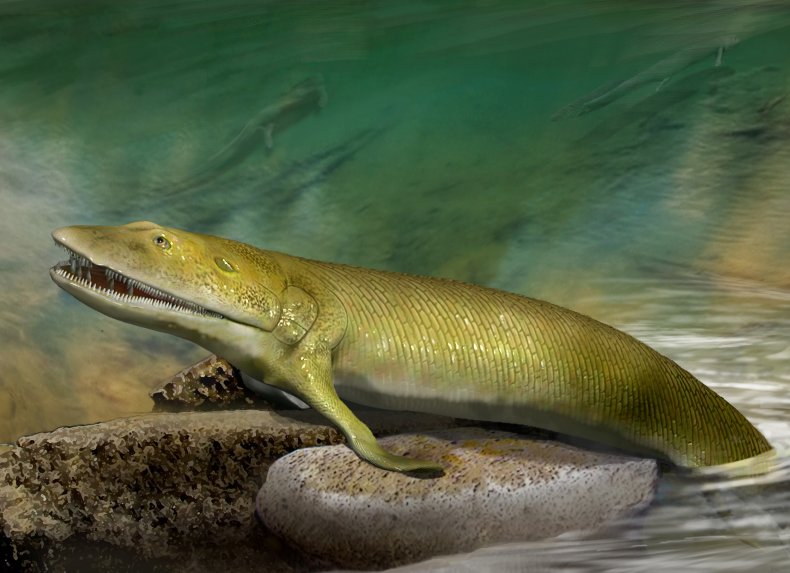Scientists have discovered a 380-million-year-old fossil in eastern Canada which sheds new light on the transition between fish and the first four-legged animals that made their way onto land, and the origins of the vertebrate hand.
The researchers discovered the most complete specimen to date of an animal known as Elpistostege watsoni — which is thought to be a midway point between fish and land vertebrates — according to a study published in the journal Nature.
“Elpistsostege is a kind of ancient lobe-finned fish that lived 380 million years ago, which our paper reveals is closer to the first amphibians — part of a group of four-limbed vertebrates known as tetrapods— than any other known fish, alive or extinct,” John Long, an author of the study from Flinders University in Australia, told Newsweek.
“These fishes—called elpistostegalians—are the ones that gave rise to the first tetrapods, so share many advanced features with early tetrapods. We found it has a front fin (pectoral fin) equivalent to the arm in land animals, that shows the presence of rows of digit bones—the same bones in the fingers of your hand,” he said.
According to the researchers, the finding indicates that the vertebrate hand bone pattern first originated in fishes like Elpistostege at least 380 million years ago, before they had left the water and moved onto land.
“The previous thinking was that digits first evolved in tetrapods as part of their evolutionary adaptation to living on land, so this rewrites the story of how hands evolved,” Long said.
The authors say that this is the first time that digits, as seen in tetrapods, have been found in a fin that was covered in scales and fin rays, like we see in fishes.
“This discovery and research provide a better understanding on one of the most significant events in the evolution of vertebrates, the origin of tetrapods or the transition between aquatic fishes and terrestrial tetrapods,” Richard Cloutier, a co-author of the study from Université du Québec à Rimouski, Canada, told Newsweek.
“Until our discovery, a few species of prehistoric lobe-finned fishes were known to have lobed pectoral fins covered by scales and having fin rays. Inside these fins, precursors to tetrapod bony elements were also present, including the humerus (arm,) radius and ulna (forearm,) and occasionally some small distal bones, the ‘radials’ which are similar to wrist bones,” he said. “Our Canado-Australian team is describing, for the first time, small distal bones within the fins which are organized in digits.”
The 1.57-meter-long (around five feet-long) specimen, which the team describe in the paper, was found in the Miguasha cliffs along the Gaspé Peninsula in eastern Quebec. The researchers used state-of-the-art computed tomography scanning technology to virtually visualize the complete fossil and the pectoral fin.
“Elpistostege was primarily an aquatic animal, with a crocodile-like shape, living in a large estuary along the south coast of a continent that we identify as Euramerica, which includes today’s North America and part of Europe,” Cloutier said.
“During the Devonian Period (419-559 million years), Miguasha was located a little south to the equator and therefore a warm climate prevailed. On the continent near the estuaries and rivers, the first forests of 10-meter high tree-like ferns were growing. On land there were no vertebrates, only different types of invertebrates such as scorpions and millipedes. In the shallow estuary, Elpistostege was living with some 20 different species of fishes,” he said.

Previously, scientists knew that fishes like Elpistiostege and a handful of other transitional animals such as Tiktaalik, were seemingly very advanced compared to other fishes, and more closely related to tetrapods.
“Our new discovery shows the pectoral fin structure in complete detail for the first time in any of these fishes. Elpistostege reveals its pectoral fin skeleton is closer to the arm and hand bone pattern in tetrapods than any other fish. [This] suggests these fishes were capable of bearing weight on the front fin and that the origin of the hand in land animals involved losing the fin rays and then came further development of digit bones to form free moving digits,” Long said.
“[The discovery] shows that some of the big steps in evolution we thought were restricted to land animals actually first took place in fishes, long before they left the water to invade land,” he said. “It rewrites the biology textbooks about how our limbs evolved and how fingers originated. It gives us deeper insights in the the very processes of evolutionary transformations, and that the anatomical changes in the transition from fishes to land animals began much earlier in fishes than we previously thought.”
According to Cloutier, Elpistostege is the closest we can get to a “missing link” between fish and tetrapods, which include amphibians, reptiles, birds, and mammals.
“I think that Elpistostege can now be considered as one of these emblematic taxa, such as Archaeopteryx and Australopithecus, that reveals a significant segment of evolution,” he said.





